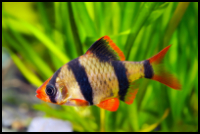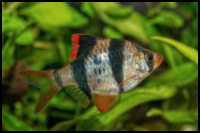




Quick Care Details (Table)
| Livestock Characteristics | Value |
|---|---|
| Care Level | Easy |
| Temperament | Semi-Aggressive |
| Diet | Omnivore |
| Maximum Size | 3 Inches |
| Minimum Tank Size | 20 Gallons |
| Plant Safe | Yes |
| Temperature Range | 74-79F |
| PH Range | 6.0-7.0 |
| KH Range | 4-10 |
Species Specific Categories
Helpful Video
Care Details
Aquascape: When you're creating a habitat for Tiger Barbs, think about the kind of river-like setting they come from in Southeast Asia. They like a mix of live or artificial plants and open swimming spaces. But be mindful with delicate plants, as Tiger Barbs can be a bit nippy.
Substrate: Go for fine gravel or sand as the tank bottom. It's kind of like bringing their natural riverbed into your tank, and they love it for their digging and exploring.
Disease Prevention: Just like with any pet, keeping a clean and balanced environment is essential. That means good water quality, a healthy diet, and regular tank maintenance. Tiger Barbs are pretty tough, but like anyone, they can get sick if things get messy.
Filtration: You'll need a good filter to keep the water clean. Tiger Barbs are pretty active, and with activity comes more waste. A reliable filter is a must to keep the water clear and safe.
Lighting: Keep it moderate. You don't need super bright lights. Tiger Barbs are chill with a regular lighting setup.
Water Flow: They prefer a gentle water flow. So, don't make the water rush around too much.
Hardiness: These guys are survivors. They can handle different water conditions, but they like stability. Keep things consistent, and they'll be happy.
Acclimation: If you're introducing new Tiger Barbs to the tank, take it slow. Let them get used to the water slowly. It's like letting someone dip their toes in before jumping into a pool.
Expected Lifespan: In a well-kept tank, Tiger Barbs typically hang around for about 5 to 7 years. But some can push that even further.
Special Requirements: Be picky with their roommates. Tiger Barbs can be a little feisty and might nip at other fish. Stick with buddies that are close in size and temperament. Keep them well-fed with a mix of regular food and some treats, like live or frozen meals, and you'll have some happy campers on your hands.
Temperament and Behavior
Behavior: Tiger Barbs are known for their spunky personalities. They're active and playful, always on the move. These little fish have a curious nature and will often explore every nook and cranny of your tank. They enjoy playing games with tank decorations and chasing each other, which is why they are often the center of attention in a community tank.
Breeding: Breeding Tiger Barbs can be an exciting experience. They are egg layers, and to encourage spawning, provide them with fine-leaved plants or a breeding mop in a separate breeding tank. Once the female lays her eggs, the male fertilizes them. After that, it's time to remove the adult fish to prevent them from eating the eggs. Young Tiger Barbs, known as fry, will hatch in a few days.
Aggression: Tiger Barbs have a reputation for being a bit feisty. They can display some nippy behavior, especially if kept in too small a group. To curb this, maintain a group of at least six or more, which helps to disperse their aggression. You may also want to avoid keeping them with slow-moving or long-finned fish, as Tiger Barbs might nip at their fins.
Tankmates Compatibility: Careful selection of tankmates is key. Choose fish that can hold their own and aren't easily intimidated by Tiger Barbs' active nature. Good companions include other semi-aggressive or fast-moving fish like Danios, Rainbowfish, and larger Tetras.
Activity Level: Tiger Barbs are little bundles of energy. They dart around the tank, often in a synchronized fashion, creating an exciting and dynamic display. They'll make your aquarium a lively and vibrant place.
Schooling or Shoaling Behavior: Tiger Barbs exhibit shoaling behavior, sticking together in a group. In the wild, this helps protect them from predators. In your tank, they should be kept in a group of at least six or more to reduce aggression and ensure they feel secure.
Plant Compatibility: Tiger Barbs are known for nibbling on live plants. They might not decimate your plants, but they can nibble at leaves and uproot them in the process. Consider hardy, fast-growing plants like Anubias and Java Ferns to withstand their curiosity.
Diet and Nutrition
Dry Foods: Tiger Barbs are quite the fans of dry foods, much like how many of us appreciate the convenience of packaged meals. They'll eagerly devour high-quality flakes and pellets, which are easy to store and offer a well-rounded diet. You'll find products specially formulated for tropical or community fish to keep them thriving.
Frozen Foods: For some gourmet dining, you can treat your Tiger Barbs to frozen delights like brine shrimp, bloodworms, and daphnia. These are akin to the occasional indulgence of a delicious dessert – they love it, and it enhances their health and vibrant colors.
Live Foods: Tiger Barbs have a real passion for live foods, which is akin to savoring farm-to-table freshness. You can occasionally offer them live or freshly hatched brine shrimp, mosquito larvae, and small aquatic insects. It's like a culinary adventure for them, and it contributes to their activity and well-being.
Vegetables: While mainly carnivorous, Tiger Barbs appreciate a side of vegetables on their plate. Think of it as a healthy salad. You can blanch veggies like zucchini, spinach, or cucumber as a delightful treat from time to time. Just be sure to clear away any uneaten portions to keep their "dining area" tidy.
Algae: Tiger Barbs are not known as ardent algae connoisseurs. If your tank has an algae issue, consider enlisting the help of dedicated algae-eating companions or take matters into your own hands.
Feeding Schedule: Just like our mealtimes, it's best to offer your Tiger Barbs two to three meals a day, with smaller servings. This mimics their natural feeding patterns. Overindulging can lead to health troubles and mess up the dining environment (water quality), so it's important to manage portions wisely.
Supplemental Foods: In addition to their regular meals, you can introduce the occasional delicacy, like freeze-dried or freeze-frozen treats. Much like enjoying a gourmet dessert after a wholesome meal, these supplementary foods add variety and are met with great enthusiasm. Remember, moderation is key to maintaining a diverse and healthy diet.
Tank Parameters
Tank Size: Think of your Tiger Barbs as active roommates. To ensure they have enough space to roam around and show off their vibrant colors, consider a tank that's at least 30 gallons. This is like giving them a comfortable and spacious living area, just as we appreciate room to move around in our homes.
Tank Length and Measurements: A longer tank, around 36 inches or more, is ideal for these zippy swimmers. Imagine it like having a longer corridor for them to zip through, providing room for their energetic antics.
Water Temperature: Tiger Barbs prefer their water to be like a warm, tropical vacation destination. Maintain a temperature range of 74-79°F (23-26°C). This ensures they're comfortable and helps replicate their native habitat.
pH (Acidity/Alkalinity): Keep the pH levels of your tank water between 6.0 to 7.5, which is slightly acidic to slightly alkaline. This range imitates their natural environment, making them feel at home and less stressed.
KH (Carbonate Hardness): Aim for a KH level of 2-10, which is similar to having just the right amount of minerals in your tap water. It ensures water stability and prevents pH fluctuations, creating a harmonious aquatic environment.
GH (General Hardness): Tiger Barbs appreciate a GH range of 4-18, resembling water that's moderately hard. This matches their native habitat and promotes their overall well-being.
Hardiness: These fish are quite hardy and resilient, much like a robust plant that can withstand various conditions. This hardiness makes them suitable for both beginners and experienced aquarists, making them a popular choice among hobbyists.
Nitrate (NO3) Levels: Keep nitrate levels below 20 ppm (parts per million) in your tank, similar to maintaining the air quality in your home. Regular water changes and good filtration will help maintain these levels, ensuring a clean and healthy environment for your Tiger Barbs.
History, Popularity, History and Species Variety Details
History: Tiger Barbs, scientifically known as Puntigrus tetrazona, have quite a backstory in the world of aquarium enthusiasts. These little aquatic gems hail from the captivating waters of Southeast Asia, specifically the rivers of Thailand, Malaysia, and Indonesia. Their journey into the aquarium world has been an enduring one. Known for their vivacious colors and spirited personalities, Tiger Barbs have been a favorite among fishkeepers for generations. They're like the classic rockstars of the aquarium scene, beloved for their vibrant hues and lively antics.
Popularity: Tiger Barbs have garnered popularity over the years, and it's easy to see why. With their brilliant orange bodies adorned with bold black stripes, they're like the fashionistas of the underwater world. Their spirited and dynamic behavior adds to their charm. Whether you're a novice or a seasoned aquarist, Tiger Barbs often find their way into home aquariums, providing an engaging and lively presence. They're the aquatic pets that never fail to brighten up the aquatic stage.
Natural Habitat: Imagine the native habitat of Tiger Barbs as picturesque streams and rivers in Southeast Asia, where the landscapes are adorned with lush, dense vegetation. These regions boast a warm, tropical climate and an abundance of aquatic plant life. In the wild, Tiger Barbs prefer slow-moving waters that offer a blend of submerged greenery and open spaces. When you set up your aquarium to mimic these conditions—warmer waters, live plants, and open swimming areas—you're essentially recreating a slice of their native environment. It's like inviting the natural beauty and vibrancy of Southeast Asia into your own aquatic haven.
So, by welcoming Tiger Barbs into your aquarium, you're not just getting fish; you're bringing a touch of their Southeast Asian heritage, along with a rich history and a dash of the classic charm that has made them beloved in the aquarium world. It's like having a living piece of nature right in your own living space.
Variations of the Tiger Barb
- Albino Tiger Barb: Albino Tiger Barbs are recognized by their striking, almost translucent bodies. They lack the typical black stripes seen in the wild-type Tiger Barbs, and their colors are replaced by a golden hue. The red-orange pigmentation is particularly prominent, giving them an eye-catching appearance.
- Green Tiger Barb: The Green Tiger Barb, also known as the Moss Green Tiger Barb, features a more subdued coloration compared to its vibrant counterparts. These fish display a greenish-gold body with faint tiger stripes, which can make them appear more subdued and less flashy than the classic Tiger Barb.
- Longfin Tiger Barb: Longfin Tiger Barbs are known for their distinctive long, flowing fins, which add an elegant touch to their appearance. They retain the traditional Tiger Barb coloration but with an added grace due to their extended finnage.
- Platinum Tiger Barb: Platinum Tiger Barbs are another color morph that has been selectively bred to have a shimmering, silvery-white body. These Barbs have the same pattern of black stripes as the standard Tiger Barbs but with a different color palette.
Frequently Asked Questions
Are Tiger Barbs suitable for beginners?
Tiger Barbs are hardy and can be a good choice for beginners, but they are known for their fin nipping behavior, which might be challenging for some novice aquarists.
How many Tiger Barbs should I keep together?
They are social fish and thrive in groups of at least six. Larger groups help spread out their aggression.
What's the best tank size for Tiger Barbs?
A 20-gallon tank is a minimum for a small group, but a larger tank is recommended for more Tiger Barbs.
Can Tiger Barbs live with other fish?
They can coexist with other semi-aggressive fish, but avoid slow, long-finned species that they might nip.
What should I feed Tiger Barbs?
They are omnivores and accept a variety of foods, including flakes, pellets, live, and frozen foods. A varied diet is best.
Do Tiger Barbs need plants in their tank?
Plants can provide cover and mimic their natural habitat, but they might nibble on some plants.
Do Tiger Barbs require any special water conditions?
They adapt to a wide range of water conditions but prefer slightly acidic to neutral pH and temperatures around 72-79°F (22-26°C).
Can Tiger Barbs change their color?
Yes, their colors can intensify or fade depending on their mood and health.
Do they make any sounds?
Tiger Barbs don't vocalize, but they may produce clicking sounds by grinding their pharyngeal teeth.
How long do Tiger Barbs live?
With proper care, they can live for 6-7 years, although some have been known to live longer.

